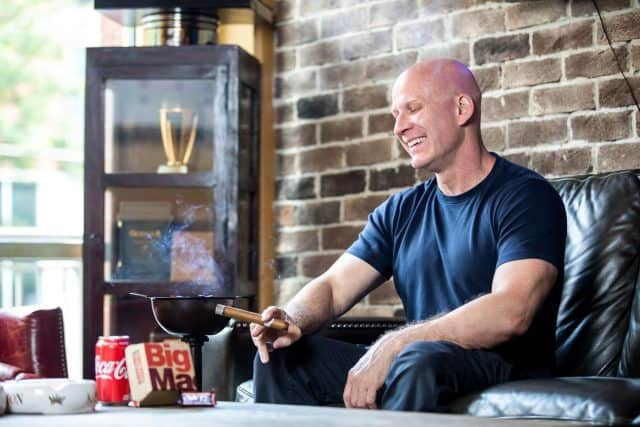When it comes to marketing, the endgame is almost always to increase brand awareness, strengthen relationships between companies and consumers, and boost market share. But counter-marketing efforts are often employed to reduce consumption of “vice” goods such as cigarettes, sugary sodas, and fast food.
Earlier this year, Michael “Mike” Lewis, professor of marketing, faculty director, Emory Marketing Analytics Center, published “Investigating the Effects of Excise Taxes, Public Usage Restrictions, and Anti-Smoking Ads across Cigarette Brands.” in the Journal of Marketing. Mike, along with co-authors, Yanwen Wang PhD14, associate professor of marketing and Canada research chair in Marketing Analytics at the University British Columbia, and Vishal Singh, professor of marketing, Leonard N. Stern School of Business, New York University, took a closer look at the role counter-marketing plays in the consumption of “vice” goods.
Given that many “vice” categories are dominated by high-equity brands such as Marlboro, McDonald’s, and The Coca-Cola Company, the authors wanted to explore whether or not strong brands “might also affect the efforts of advocacy groups and regulators to disrupt these relationships and reduce consumption,” they note in their paper.
The research focused specifically on the interplay between branding and counter-marketing with respect to cigarette consumption. By focusing on brand manufacturers rather than on regulators and consumers, the authors believe they’ve closed a gap. “The literature on smoking cessation has largely ignored the impact of branding on efforts to reduce cigarette consumption,” they write. “This is an oversight given that marketing researchers have found that brand-consumers’ relationships have significant effects on consumer decision-making.”
For Impact, Smoke-Free Restrictions Lead the Pack
The researchers expected that strong brands would take advantage of their increased customer loyalty and diminished price sensitivity to protect them from counter-marketing tactics. However, the authors’ findings also revealed that strong brands such as market-leader, Marlboro, should favor specific governmental policies over others and structure their efforts to shape policy accordingly.
“This isn’t a clear-cut battle of good versus evil. It’s more a matter of a brand’s people advocating for one position,” said Lewis. “A position that’s going to make them more resilient to some of these tactics.”
To come to their conclusions, the researchers used multiple data sets from 2006 through 2010 and they studied three specific antismoking counter-marketing efforts: smoke-free restrictions, anti-smoking advertising, and excise taxes.
They found that smoke-free restrictions had the greatest influence on big brand purchases. According to the paper: “As smoke-free restrictions become stricter and more prevalent, preference for Marlboro is significantly reduced compared with other brands. The smoke-free findings are especially interesting from public health and marketing perspectives.”
When the authors ran a “complete smoke-free restrictions” simulation, category volume decreased by 7.5% and the quit rate increased by 9.1%. The losses for big brands such as Marlboro and Winston were 14% and 16.3%. Low-price brands suffered less severe losses of approximately 8%.
Whether due to the quality of the campaigns or overall “numbness” to anti-smoking messaging, the authors found consumers to be relatively unaffected by such advertising. When the authors doubled anti-smoking education campaigns in their simulations, they noticed “relatively little effect” on cigarette consumption—a mere 1% drop in category volume.
The authors’ most notable discovery was the effect of excise taxes on big brands. Tax hikes did reduce overall category consumption, but “stronger brands tend to gain share following tax hikes,” the authors note.
So What’s Next for “Vice” Brand Marketing?
While it might be counter-intuitive, the author’s research suggests that market leading cigarette brands would be better off pushing for excise taxes on cigarettes (versus smoking restrictions), as such tax increases would be attractive to government agencies (by increasing government revenue), and big brand cigarette companies would capture more market share. In other words, when it comes to combating counter-marketing efforts, “brand managers may devise strategies or lobbying efforts based on their category position,” suggest the researchers.
In addition to big brand cigarette companies, the paper’s findings have implications for brands that anchor other vice categories, such as McDonald’s and The Coca-Cola Company, entities that have been the target of counter-marketing campaigns by various anti-obesity groups.
According to Lewis, Wang, and Singh’s research, much of the response by these brands to the counter-marketing attempts has been centered around public relations, but the authors see opportunities to employ “different tactics” that are “appropriate for different brands,” they write. “Relationships between consumers and relatively weak brands may be disrupted using taxes, while for strong brands, the appropriate tactic seems to be usage restriction that limit public consumption. Our results suggest that brand building is the correct response to taxes, whereas usage restrictions would call for other responses, such as lobbying.”
In addition to exploring trends in the overall marketing landscape, Mike Lewis is an expert in sports analytics and marketing. For fascinating insight, podcasts, and commentary on “Fanalytics,” visit Mike Lewis’s website. Check out the Emory Marketing Analytics Center, a cutting-edge academic research group that uses empirical data and statistical approaches to investigate passionate consumer and fan loyalty, brand marketing, decision support models, and analyses to support firms’ explanatory and predictive efforts. Learn more today.











